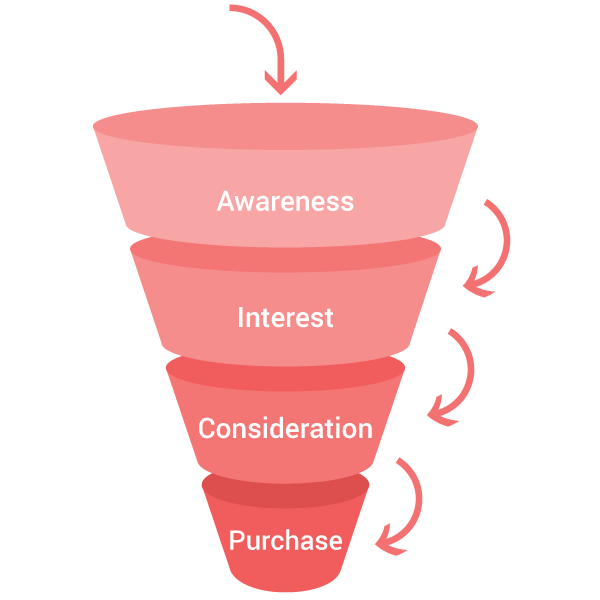Back in the day, marketing was a straightforward venture. You’d place an ad in the newspaper, buy a billboard, maybe record a radio commercial””then sit and wait until someone called in.
When digital marketing hit the scene, it opened up virtually endless opportunities. But with endless opportunities comes endless confusion. There’s social media, pay-per-click, blogging, email, and more. Where do you start?
To market your business effectively, you need to start with a strategy. Luckily, modern marketing provides a blueprint that works for virtually any business.
Meet the marketing funnel.
What is a marketing funnel?
A solid marketing strategy takes into account shoppers who are at different stages. Some have only barely heard of your company, some are interested but not ready to purchase, and some just need a final push to make them into customers.
A marketing funnel is the perfect tool for visualizing these different shoppers. In the words of Wikipedia, a marketing funnel (or purchase funnel, as they call it) is “a consumer focused marketing model which illustrates the theoretical customer journey towards the purchase of a product or service.”
At the top of the funnel are those who are aware of your business. As you communicate with them, they may begin to express interest. Your goal is to continue pushing them down the funnel through good marketing and communication to the point where they consider your business against other options, then finally make a purchase.

You might have seen versions of the funnel with different steps. Individual businesses might break down the steps further, but the basic progression is the same.
The benefit of a marketing funnel is it helps you visualize goals for your marketing. For example, to move a customer into the awareness stage at the top of the funnel, your goal should be to make your name known to strangers. Then, to move them to the interest stage, you’ll need a way to present something interesting to those who’ve heard of your business communicate with those who are aware of you””and so on. The magic is in those little red arrows you see in the diagram.
Marketing is the journey you take a buyer on to guide them to purchase. The marketing funnel is the perfect tool for visualizing and crafting that journey.
Creating a marketing plan based on the funnel
This is where it gets good.
To start building and understanding your own marketing funnel, you’ll want to create a list of all of your marketing efforts. Don’t overthink it””this list should include anything you’ve done or are doing in an effort to bring in new customers. It includes the pages on your website, groups you’ve reached out to, and your Facebook page. It also includes any emails you’ve sent, promotions you’ve advertised, and client gifts. Wherever you are and whatever you’ve done, write it down.
Next, take a look at the funnel, and identify how those efforts you’ve taken move people from one stage to the next. For example, you might be reaching out to local schools who’ve never heard of your business in order to pitch a custom online spirit gear store with you. That action would move them into awareness, and possibly into interest as well. If you have an “about us” page on your website, that may help people who are in the consideration stage move to purchase, as they may likely begin to trust you more.
There’s no right answer here, and many of your actions may be relevant in multiple stages. Again, this a model. An exercise. Work through it as a way to visualize the various ways your potential customers interact with your business.
Improving your funnel
If you’re having trouble filling in a certain step, it’s a good indicator that you have a leaky funnel, and it’s time to brainstorm and test new ways of moving customers into the next stage. Brainstorming and testing is also the way to go if your marketing efforts seem robust, but you’re still sure why you’re getting the sales you want. Do some research and generate a few ideas to try. Then, test.
To test the effectiveness of an action you’re taking in your funnel, you need to understand what metrics would make that action a success. For example, maybe you’re posting to your Facebook business page twice a day. But have you checked the Facebook Insights tab?
![]()
If you’re not getting much engagement (clicks, comments, likes), maybe it’s not worthy of so much of your time. Or maybe you find that lots of people are coming to your website, but none of them are making purchases (a key metric!). In that case, you need to work on making your website a tool that pushes visitors from Interest to Consideration, and Consideration to Purchase.
Bonus: How InkSoft factors into your marketing funnel
InkSoft has all of the tools to help you run a successful printing business. However, its primary purpose lies in the end of the funnel. A professional e-commerce site is designed to help move shoppers from Interest to Consideration and/or Purchase.
Below are a few marketing funnel samples we’ve put together. These are simplified, as a real marketing funnel may look more like a combination of all three of these. However, this should serve as an outline of how different marketing efforts worth together.
Example 1
To move into Awareness: I run Facebook Ads that direct to our InkSoft store. I also ask customers to tell their friends about our business after every purchase.
To move into Interest: I’ve implemented SEO on our website so it’s easily searchable on Google. That way, when those referrals come looking for us, they find our website easily.
To move into Consideration: Our website has lots of information on it, like an “About Us” page with our company values. We also have an email newsletter sign-up form on our website so we can capture leads (visitor emails) and continue marketing to them.
To move into Purchase: I use the email newsletter to share coupons, sales, useful content, new product announcements, and company news, which keeps customers interested in what we’re doing and directs them back to the store regularly.
Example 2
To move into Awareness: I reach out directly to local schools and nonprofits and schedule in-person meetings where I pitch our fundraising services through InkSoft fundraising stores. I also host a booth at local events a few times a year.
To move into Interest: I provide brochures with our pricing and services, as well as some information on who we are as a business.
To move into Consideration: I stay in touch with prospects via phone and email to answer questions.
To move into Purchase: If a prospect still hasn’t purchased after a few weeks, I’ll reach out with a special promotion to encourage them to buy. I also send birthday cards and other notes to stay top-of-mind throughout the year.
Example 3
To move into Awareness: I have a prominent physical storefront and a strong presence in the community. I also run occasional contests on Instagram to attract new followers in my target demographic. I occasionally run ads in local magazines promoting our services and specials.
To move into Interest: I post often on Instagram, sharing interesting photos and showing off our capabilities to our followers.
To move into Consideration: I show store visitors product samples and make sure they leave with a packet of information. I encourage Instagram followers to visit our InkSoft store.
To move into Purchase: I follow up regularly with prospects who’ve visited our physical store and encourage them to create their design in the InkSoft Design Studio. Instagram visitors are also easily guided to the Design Studio and through the purchase process.
Don’t have an InkSoft store?
InkSoft is the leading e-commerce platform for the print and customization industry. Thousands of print professionals have used InkSoft to get rid of paper order forms, simplify art approvals, and grow their businesses online. Want to see InkSoft in action? Request a personal product tour!



I am a big fan of the know, like, and trust model also! Tracking conversions can be cumbersome – what is the best way to track cart conversions within Inksoft? We use the Business Tools side of order processing most often – tracking conversions there would be ideal.
Hey Jason, InkSoft can integrate with Google Analytics via Google Tag Manager! Here are some how-to’s from the InkSoft Help Center.
Setting Up Google Tag Manager
Using Google Tag Manager